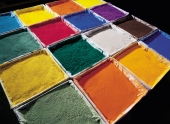
The main use of titanium dioxide (TiO2) is as a white powder pigment because of its brightness and very high refractive index. This means that relatively low levels of the pigment are required to achieve a white opaque coating. One of the major advantages for titanium dioxide is its resistance to discolouration under ultraviolet (UV) light in exposed applications.
It is used in products such as paints and coatings, including glazes and enamels, plastics, paper, inks, fibres, foods, pharmaceuticals and cosmetics. In particular, high performance grades of TiO2 are finding a growing market in the cosmetics sector and most toothpastes use TiO2.
Its UV light resistance properties helps prevent the discolouration of plastics in sunlight. Sunscreens also use TiO2 as a blocker because of its high refractive index and the ability to protect the skin from UV light.
Titanium dioxide is seeing growing demand in photocatalysts due to its oxidative and hydrolysis properties. As a photocatalyst, it can improve the efficiency of electrolytically splitting water into hydrogen and oxygen, and it can produce electricity in nanoparticle form. Applications include light-emitting diodes, liquid crystal displays (LCDs) and electrodes for plasma displays.
Under exposure to UV light, it becomes increasingly hydrophilic and can be used for anti-fogging coatings and self-cleaning windows. It also has disinfecting properties making it suitable for applications such as medical devices, food preparation surfaces, air conditioning filters and sanitary ware surfaces.
In mildly reducing atmospheres, TiO2 tends to lose oxygen and becomes a semiconductor. The electrical resistivity of the material can be correlated to the oxygen content of the atmosphere and hence it can be used as an oxygen sensor.
However, the major consuming industries of TiO2 are in the mature sectors in the developed world such as paints and coatings applications, paper and paperboard, and plastics. Therefore the consumption of TiO2 tends to follow general economic trends.
Economic downturn hits demand
In 2009, demand was impacted by the economic downturn. For example, demand in Europe was estimated to be down by 10% compared to 2008. However, markets tightened considerably in 2010 as demand recovered while supplies were constricted by plant outages. This is one of the reasons for a shortage of paint for highway construction.
Global demand growth for TiO2 is estimated to average 2.7%/year in the 10 years to 2019, according to the UK consultant Artikol. Growth will be driven by China which is estimated to grow at 5%/year. A lot of potential is also seen in India in the next 10 years.
China would remain a significant import market, particularly for the chloride-based pigment to serve the automotive industry. Artikol estimates that China imported 250,000 tonnes of chloride pigment in 2009.
Most new investment is focussed in China where production capacity was estimated at 1.1m tonne/year at end of 2009. Projects include a 200,000 tonne/year plant planned by DuPont for start up in 2014.
In western Australia, a 40,000 tonne/year expansion by Tiwest, a joint venture between Tronox and Exxaro, was commissioned in mid-2010. The expansion boosts the plant’s capacity to 150,000 tonne/year.
(Updated: July 2010. Source: ICB Chemical Profile, 4 January 2010.)